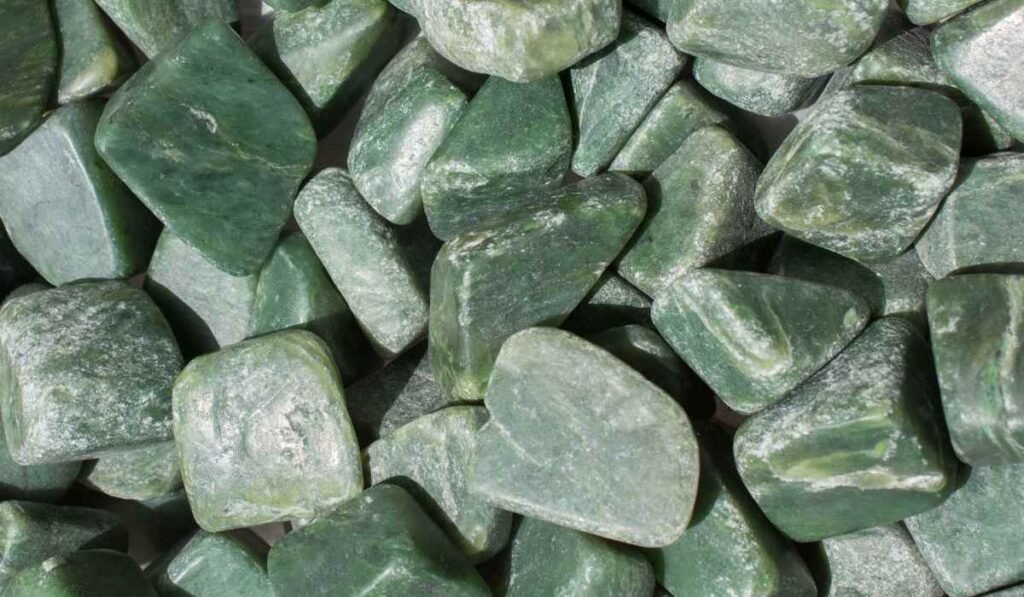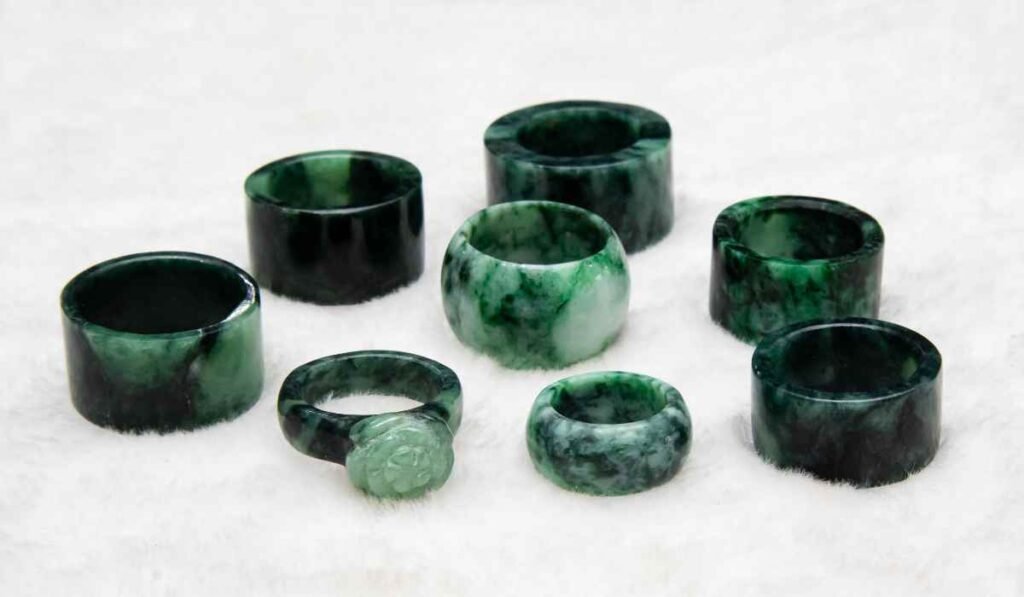Jade is a precious gemstone known for its beauty and cultural significance. It has been treasured for centuries for its beauty and symbolic significance. Buying jade can be a rewarding experience, but with imitations on the rise, it’s crucial to verify authenticity.
In this guide, we will look into how to tell if jade is real or fake using working testing methods.
Table of Contents
ToggleWhat is Jade?
It has been valued for centuries in various cultures around the world. With a smooth and often waxy appearance, jade is admired for its toughness, making it suitable for carving intricate designs and crafting exquisite jewelry.
In many traditions, especially in East Asia, jade is associated with positive qualities such as good luck, prosperity, and protection. Its enduring popularity stems from both its aesthetic appeal and symbolic importance.

What are the types of Jade?
There are two types of Jafe minerals: nephrite and jadeite. These minerals are prized for their toughness, which makes them suitable for carving and jewelry. Here’s a brief overview of each:
Nephrite Jade
Nephrite is the more common type of jade and has been used for centuries in various cultures. It is composed of calcium and magnesium silicate minerals.
Nephrite jade is often found in shades of green, but it can also be white, brown, or black. It has a smooth, waxy luster and is known for its toughness, making it suitable for carving intricate designs.
Jadeite Jade
Jadeite Jade is rarer and is considered more valuable than nephrite. Jadeite is composed of sodium and aluminum silicate minerals. It comes in a broader range of colors, including green, lavender, red, yellow, and white.
The most valuable and sought-after color in jadeite is a vibrant green. Jadeite is often used in high-quality jewelry, and it’s particularly popular in East Asian cultures.
Characteristics of Real Jade
Color: Genuine jade comes in various shades, but vibrant greens are most common. Be cautious of overly vivid or uniform colors, as they may indicate a fake.
Texture: Run your fingers over the surface. Real jade feels smooth, almost waxy, due to its fine crystal structure. Imitations often lack this natural texture.
Transparency: Hold the jade up to the light. Authentic jade may have a slight transparency. If it’s completely opaque, it could be fake.

5 Testing Methods for Jade
Testing the authenticity of jade involves various methods to ensure you’re dealing with genuine specimens. Here’s a breakdown of testing methods, with specific steps for each:
Color and Texture Test
- Authentic jade exhibits a range of colors, including shades of green, lavender, red, yellow, white, brown, or black.
- Look for a smooth and sometimes waxy texture, especially in carved or polished pieces.
Scratch Test
- Use a sharp object, such as a knife or piece of glass.
- Attempt to scratch the surface of the jade.
- Genuine jade is tough and should not easily scratch.
Density Test
- Weigh the jade specimen using a precise scale.
- Calculate its density by dividing the weight by the volume.
– Fill a container with a known volume of water.
– Submerge the jade specimen in the water, causing the water level to rise.
– Measure the change in water volume. The difference represents the volume of the jade.
Calculating Density of Jade:
- Use the formula: Density = Mass / Volume
- Substitute the measured mass and volume values into the formula.
- The result will be the density of the jade specimen in grams per cubic centimeter (g/cm³).
Example:
Let’s say you have a high-quality nephrite jade specimen with a measured mass of 50 grams and a volume of 15 cm³.
Density = Mass / Volume Density = 50 g / 15 cm³ Density = 3.33 g/cm³
In this example, the calculated density of the jade falls within the high-quality range for nephrite jade. This information, when combined with other testing methods, contributes to a more comprehensive assessment of the jade’s authenticity.
| Jade | Low-Quality | Medium-Quality | High-Quality |
|---|---|---|---|
| Nephrite Jade | 2.90 – 3.03 g/cm³ | 3.03 – 3.20 g/cm³ | 3.20 – 3.33 g/cm³ |
| Jadeite Jade | 3.10 – 3.20 g/cm³ | 3.20 – 3.30 g/cm³ | 3.30 – 3.36 g/cm³ |
Authentic jade has a specific density range; deviation may indicate a fake.
Sound Test
- Gently tap the jade with a non-metallic object.
- Authentic jade produces a musical and resonant sound.
- Be cautious of a dull thud, which could indicate a substitute material.
UV Light Test
- Expose the jade to ultraviolet (UV) light.
- Genuine jade often exhibits a fluorescent glow, especially in shades of green.
- Some fakes may not fluoresce or show a different color under UV light.
Professional Appraisal
While at-home tests provide valuable insights, the importance of seeking professional opinion cannot be overstated. A reputable jeweler or gemologist brings a wealth of experience to the table, offering a comprehensive appraisal that goes beyond the capabilities of at-home testing.
- Consult with Experts: Seek out experienced professionals in the field of gemology or jewelry appraisal.
- Choose Reputable Services: Opt for established jewelers or gemologists with a track record of expertise.

Common Mistakes to Avoid in finding real Jade
Navigating the realm of jade authenticity is not without its pitfalls. Recognizing and steering clear of common mistakes is paramount. Avoid misjudgments in color interpretation, and be vigilant against the allure of counterfeit jade to make informed and authentic purchases.
- Color Misinterpretation: Be wary of misjudging color variations as a sign of authenticity.
- Vigilance Against Counterfeits: Exercise caution to avoid falling prey to the allure of counterfeit jade.
What can be mistaken for jade?
Identifying genuine jade can be challenging, as several materials share visual similarities. Green gemstones like aventurine, serpentine, and green jasper may resemble jade due to their comparable color.
Additionally, synthetic materials such as glass, plastic, and dyed quartz can be crafted to imitate jade’s appearance, lacking its unique properties. While nephrite and jadeite jade are occasionally confused, distinguishing them involves considering differences in mineral composition and density.
Natural stones like prehnite, amazonite, and bowenite can also be mistaken for jade, emphasizing the importance of examining hardness, density, and fluorescence. Some imitations use plastic or resin, lacking the inherent toughness of genuine jade.
In UV light tests, substitutes like glass may not exhibit jade’s characteristic fluorescence. To avoid mistakes, it’s essential to employ a combination of testing methods, including scratch tests, density measurements, and UV light examinations.
Seeking guidance from gemologists ensures a more accurate identification, aiding in distinguishing true jade from its various substitutes.
Does real jade crack easily?
Genuine jade, both nephrite and jadeite, is renowned for its toughness and durability. While it’s not indestructible, real jade is less likely to crack or break easily under normal wear and tear.
Is jade worth anything?
Yes, jade is considered a valuable gemstone. Its worth is influenced by factors such as type (nephrite or jadeite), color, clarity, cut, and cultural significance. High-quality jade, especially in vibrant colors like emerald green, can command significant value.
Does real jade scratch easily?
While jade is tough, it’s not scratch-proof. Use a harder material to gently scratch an inconspicuous area. If it leaves a mark, your jade might be genuine.
Can UV light definitively identify real jade?
While not foolproof, genuine jade often exhibits a unique fluorescence under UV light. It’s an additional tool rather than a definitive test.
Why does authentic jade feel cooler than imitations?
Authentic jade’s unique molecular structure allows it to stay cooler than the surrounding environment, a trait not replicated by most imitations.
Should I solely rely on DIY tests to confirm jade authenticity?
While DIY tests are helpful, seeking professional appraisal from a jeweler or gemologist is advisable for a conclusive assessment.
By combining visual inspection and simple tests, you can confidently identify genuine jade. Stay vigilant in the market, and make informed purchases to treasure your jade for a lifetime.
